Bingbing Zhuang
Drive-1-to-3: Enriching Diffusion Priors for Novel View Synthesis of Real Vehicles
Dec 19, 2024Abstract:The recent advent of large-scale 3D data, e.g. Objaverse, has led to impressive progress in training pose-conditioned diffusion models for novel view synthesis. However, due to the synthetic nature of such 3D data, their performance drops significantly when applied to real-world images. This paper consolidates a set of good practices to finetune large pretrained models for a real-world task -- harvesting vehicle assets for autonomous driving applications. To this end, we delve into the discrepancies between the synthetic data and real driving data, then develop several strategies to account for them properly. Specifically, we start with a virtual camera rotation of real images to ensure geometric alignment with synthetic data and consistency with the pose manifold defined by pretrained models. We also identify important design choices in object-centric data curation to account for varying object distances in real driving scenes -- learn across varying object scales with fixed camera focal length. Further, we perform occlusion-aware training in latent spaces to account for ubiquitous occlusions in real data, and handle large viewpoint changes by leveraging a symmetric prior. Our insights lead to effective finetuning that results in a $68.8\%$ reduction in FID for novel view synthesis over prior arts.
Instantaneous Perception of Moving Objects in 3D
May 05, 2024Abstract:The perception of 3D motion of surrounding traffic participants is crucial for driving safety. While existing works primarily focus on general large motions, we contend that the instantaneous detection and quantification of subtle motions is equally important as they indicate the nuances in driving behavior that may be safety critical, such as behaviors near a stop sign of parking positions. We delve into this under-explored task, examining its unique challenges and developing our solution, accompanied by a carefully designed benchmark. Specifically, due to the lack of correspondences between consecutive frames of sparse Lidar point clouds, static objects might appear to be moving - the so-called swimming effect. This intertwines with the true object motion, thereby posing ambiguity in accurate estimation, especially for subtle motions. To address this, we propose to leverage local occupancy completion of object point clouds to densify the shape cue, and mitigate the impact of swimming artifacts. The occupancy completion is learned in an end-to-end fashion together with the detection of moving objects and the estimation of their motion, instantaneously as soon as objects start to move. Extensive experiments demonstrate superior performance compared to standard 3D motion estimation approaches, particularly highlighting our method's specialized treatment of subtle motions.
LidaRF: Delving into Lidar for Neural Radiance Field on Street Scenes
May 04, 2024Abstract:Photorealistic simulation plays a crucial role in applications such as autonomous driving, where advances in neural radiance fields (NeRFs) may allow better scalability through the automatic creation of digital 3D assets. However, reconstruction quality suffers on street scenes due to largely collinear camera motions and sparser samplings at higher speeds. On the other hand, the application often demands rendering from camera views that deviate from the inputs to accurately simulate behaviors like lane changes. In this paper, we propose several insights that allow a better utilization of Lidar data to improve NeRF quality on street scenes. First, our framework learns a geometric scene representation from Lidar, which is fused with the implicit grid-based representation for radiance decoding, thereby supplying stronger geometric information offered by explicit point cloud. Second, we put forth a robust occlusion-aware depth supervision scheme, which allows utilizing densified Lidar points by accumulation. Third, we generate augmented training views from Lidar points for further improvement. Our insights translate to largely improved novel view synthesis under real driving scenes.
DiL-NeRF: Delving into Lidar for Neural Radiance Field on Street Scenes
May 01, 2024Abstract:Photorealistic simulation plays a crucial role in applications such as autonomous driving, where advances in neural radiance fields (NeRFs) may allow better scalability through the automatic creation of digital 3D assets. However, reconstruction quality suffers on street scenes due to largely collinear camera motions and sparser samplings at higher speeds. On the other hand, the application often demands rendering from camera views that deviate from the inputs to accurately simulate behaviors like lane changes. In this paper, we propose several insights that allow a better utilization of Lidar data to improve NeRF quality on street scenes. First, our framework learns a geometric scene representation from Lidar, which is fused with the implicit grid-based representation for radiance decoding, thereby supplying stronger geometric information offered by explicit point cloud. Second, we put forth a robust occlusion-aware depth supervision scheme, which allows utilizing densified Lidar points by accumulation. Third, we generate augmented training views from Lidar points for further improvement. Our insights translate to largely improved novel view synthesis under real driving scenes.
LDP-Feat: Image Features with Local Differential Privacy
Aug 22, 2023Abstract:Modern computer vision services often require users to share raw feature descriptors with an untrusted server. This presents an inherent privacy risk, as raw descriptors may be used to recover the source images from which they were extracted. To address this issue, researchers recently proposed privatizing image features by embedding them within an affine subspace containing the original feature as well as adversarial feature samples. In this paper, we propose two novel inversion attacks to show that it is possible to (approximately) recover the original image features from these embeddings, allowing us to recover privacy-critical image content. In light of such successes and the lack of theoretical privacy guarantees afforded by existing visual privacy methods, we further propose the first method to privatize image features via local differential privacy, which, unlike prior approaches, provides a guaranteed bound for privacy leakage regardless of the strength of the attacks. In addition, our method yields strong performance in visual localization as a downstream task while enjoying the privacy guarantee.
NeurOCS: Neural NOCS Supervision for Monocular 3D Object Localization
May 28, 2023Abstract:Monocular 3D object localization in driving scenes is a crucial task, but challenging due to its ill-posed nature. Estimating 3D coordinates for each pixel on the object surface holds great potential as it provides dense 2D-3D geometric constraints for the underlying PnP problem. However, high-quality ground truth supervision is not available in driving scenes due to sparsity and various artifacts of Lidar data, as well as the practical infeasibility of collecting per-instance CAD models. In this work, we present NeurOCS, a framework that uses instance masks and 3D boxes as input to learn 3D object shapes by means of differentiable rendering, which further serves as supervision for learning dense object coordinates. Our approach rests on insights in learning a category-level shape prior directly from real driving scenes, while properly handling single-view ambiguities. Furthermore, we study and make critical design choices to learn object coordinates more effectively from an object-centric view. Altogether, our framework leads to new state-of-the-art in monocular 3D localization that ranks 1st on the KITTI-Object benchmark among published monocular methods.
MM-TTA: Multi-Modal Test-Time Adaptation for 3D Semantic Segmentation
Apr 27, 2022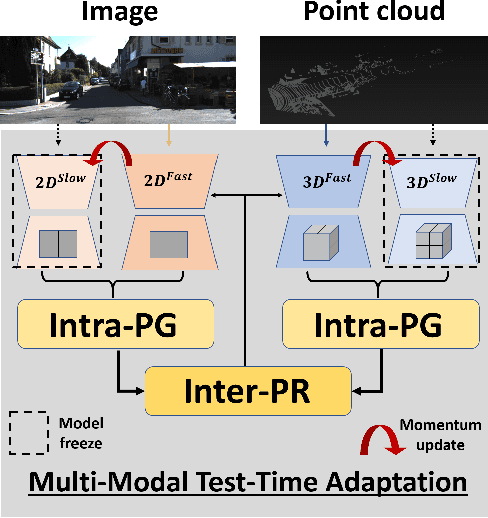
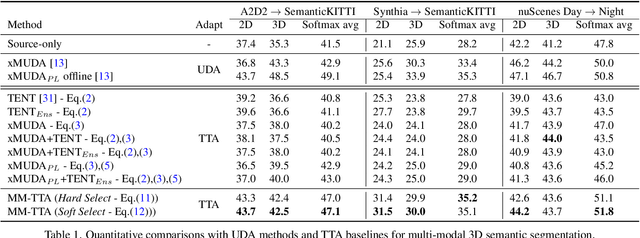
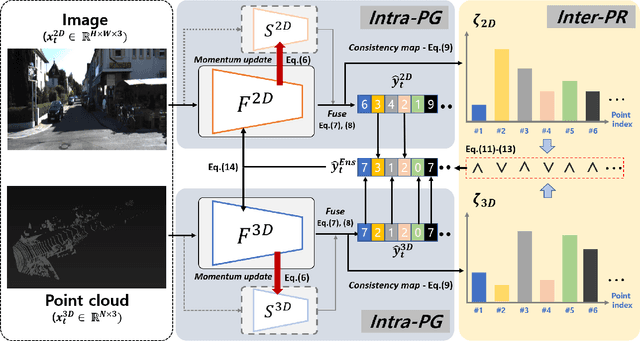

Abstract:Test-time adaptation approaches have recently emerged as a practical solution for handling domain shift without access to the source domain data. In this paper, we propose and explore a new multi-modal extension of test-time adaptation for 3D semantic segmentation. We find that directly applying existing methods usually results in performance instability at test time because multi-modal input is not considered jointly. To design a framework that can take full advantage of multi-modality, where each modality provides regularized self-supervisory signals to other modalities, we propose two complementary modules within and across the modalities. First, Intra-modal Pseudolabel Generation (Intra-PG) is introduced to obtain reliable pseudo labels within each modality by aggregating information from two models that are both pre-trained on source data but updated with target data at different paces. Second, Inter-modal Pseudo-label Refinement (Inter-PR) adaptively selects more reliable pseudo labels from different modalities based on a proposed consistency scheme. Experiments demonstrate that our regularized pseudo labels produce stable self-learning signals in numerous multi-modal test-time adaptation scenarios for 3D semantic segmentation. Visit our project website at https://www.nec-labs.com/~mas/MM-TTA.
Learning Cross-modal Contrastive Features for Video Domain Adaptation
Aug 26, 2021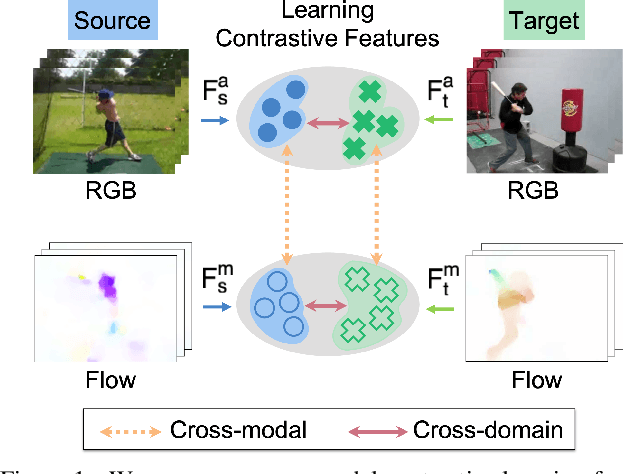
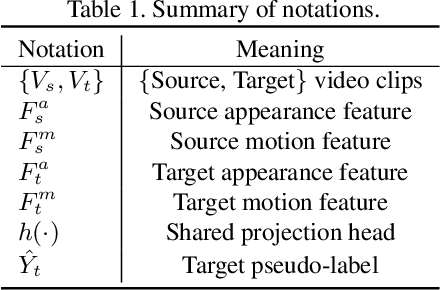

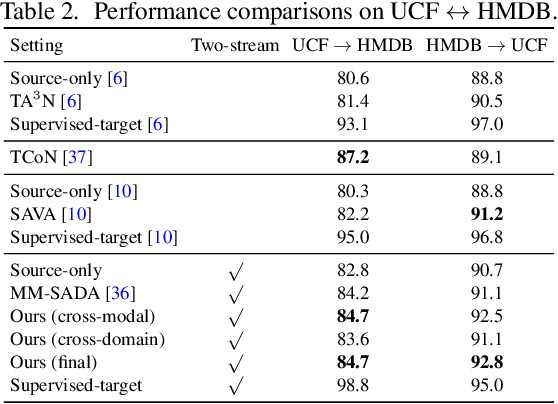
Abstract:Learning transferable and domain adaptive feature representations from videos is important for video-relevant tasks such as action recognition. Existing video domain adaptation methods mainly rely on adversarial feature alignment, which has been derived from the RGB image space. However, video data is usually associated with multi-modal information, e.g., RGB and optical flow, and thus it remains a challenge to design a better method that considers the cross-modal inputs under the cross-domain adaptation setting. To this end, we propose a unified framework for video domain adaptation, which simultaneously regularizes cross-modal and cross-domain feature representations. Specifically, we treat each modality in a domain as a view and leverage the contrastive learning technique with properly designed sampling strategies. As a result, our objectives regularize feature spaces, which originally lack the connection across modalities or have less alignment across domains. We conduct experiments on domain adaptive action recognition benchmark datasets, i.e., UCF, HMDB, and EPIC-Kitchens, and demonstrate the effectiveness of our components against state-of-the-art algorithms.
Fusing the Old with the New: Learning Relative Camera Pose with Geometry-Guided Uncertainty
Apr 16, 2021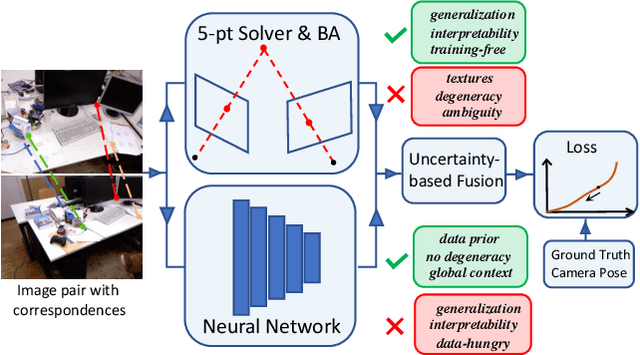
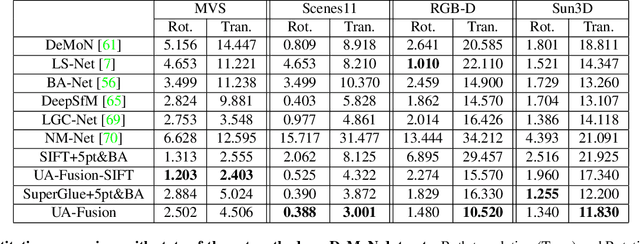

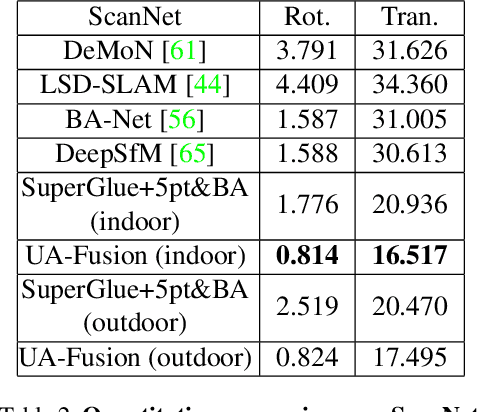
Abstract:Learning methods for relative camera pose estimation have been developed largely in isolation from classical geometric approaches. The question of how to integrate predictions from deep neural networks (DNNs) and solutions from geometric solvers, such as the 5-point algorithm, has as yet remained under-explored. In this paper, we present a novel framework that involves probabilistic fusion between the two families of predictions during network training, with a view to leveraging their complementary benefits in a learnable way. The fusion is achieved by learning the DNN uncertainty under explicit guidance by the geometric uncertainty, thereby learning to take into account the geometric solution in relation to the DNN prediction. Our network features a self-attention graph neural network, which drives the learning by enforcing strong interactions between different correspondences and potentially modeling complex relationships between points. We propose motion parmeterizations suitable for learning and show that our method achieves state-of-the-art performance on the challenging DeMoN and ScanNet datasets. While we focus on relative pose, we envision that our pipeline is broadly applicable for fusing classical geometry and deep learning.
Weakly But Deeply Supervised Occlusion-Reasoned Parametric Layouts
Apr 14, 2021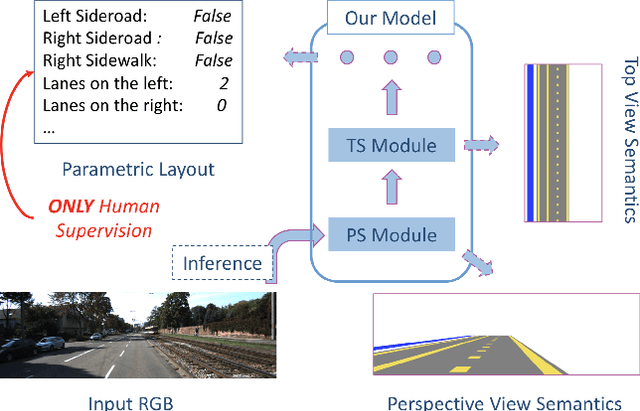

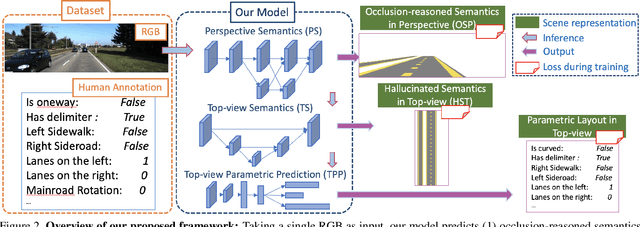

Abstract:We propose an end-to-end network that takes a single perspective RGB image of a complex road scene as input, to produce occlusion-reasoned layouts in perspective space as well as a top-view parametric space. In contrast to prior works that require dense supervision such as semantic labels in perspective view, the only human annotations required by our method are for parametric attributes that are cheaper and less ambiguous to obtain. To solve this challenging task, our design is comprised of modules that incorporate inductive biases to learn occlusion-reasoning, geometric transformation and semantic abstraction, where each module may be supervised by appropriately transforming the parametric annotations. We demonstrate how our design choices and proposed deep supervision help achieve accurate predictions and meaningful representations. We validate our approach on two public datasets, KITTI and NuScenes, to achieve state-of-the-art results with considerably lower human supervision.
 Add to Chrome
Add to Chrome Add to Firefox
Add to Firefox Add to Edge
Add to Edge